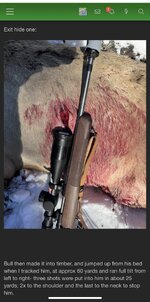You mean you haven’t had to put “four perfectly placed shots” from 25/06, 270, 270wsm’s in elk to kill them like with the 30 cal?
Do you not understand how illogical this statement above is?
You are literally saying- “it’s ok that I put four perfectly placed rounds from this big 30cal magnum- but it’s not ok that one shot from ‘x’ caliber didn’t drop an elk immediately”.
No one has an agenda here, they are just looking for logical thought processes and honesty. Your position is illogical and intellectually dishonest.
On top of that, you have functionally 0 experience with a topic, but then are giving advice about how to do it to others- advice that is absolutely wrong (400 yard max and mono’s)- and you are arguing with multiple people that have from a dozen (in one year) to hundreds of big game animals killed with 22cals- including 50+ elk.
I, and others are trying to make sense of that.
You typically don’t need 4 well rounds with a 30 magnum..
This whole shoot them 20 times until they die then call it a win is idiotic..
Fact it there’s allot of times you only get one shot, and shooting a small match bullet that typically leave a poor blood trail isn’t the right answer.
Sent from my iPhone using Tapatalk

